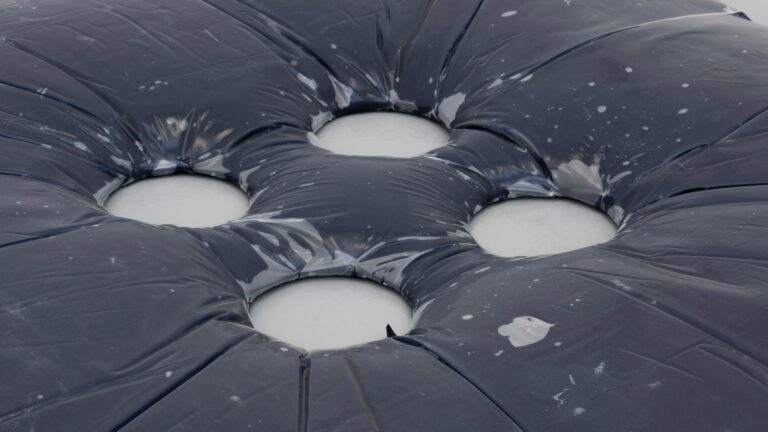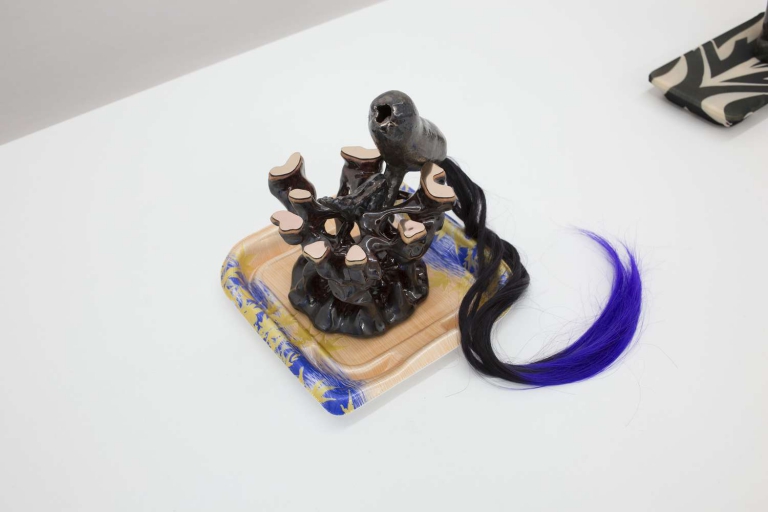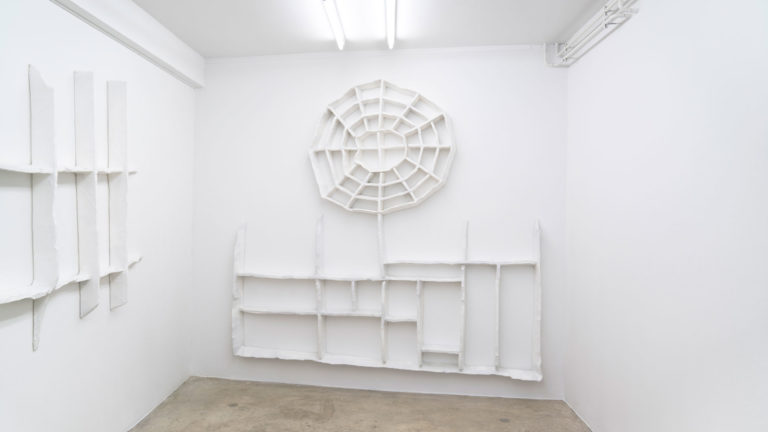Artists: Tiphaine Calmettes, Hunter Longe, Isabell Schulte
Exhibition title: Foyer Flux Fossils
Venue: CAN Centre d’Art Neuchâtel, Neuchâtel, Switzerland
Date: June 8 – August 4, 2024
Photography: Sebastian Verdon / all images copyright and courtesy of the artist and CAN Centre d’art Neuchâtel
Note: Exhibition booklet is available here
The title Foyer Flux Fossils functions like a conceptual toolbox; its elements conceal a plurality of meanings that allow us to imagine combinations of thoughts: different links can be tied together in various ways. Whether we conceive of the Foyer as the place where the fire is made, the house, the people who live there, a center from which everything starts, or simply a place for sharing; whether we imagine Flux as movement, a tide, a transmission of computer data, or even a breath that varies or is constant; whether we think of Fossils as the remains of ancient plants or animals, oil or coal, or whether the term simply refers to the soil, to what is buried and hidden between sedimentary strata, the deployment and interweaving of these terms opens up to interpretation and lexical play, like many potential overlapping stories and images. In the exhibition rooms, glitches seem to occur from time to time, here and there, a sound hums softly. Slight variations are enough to bring about a change of focus, which is how this exhibition can be approached, by shifting our perception.
We walk through a corridor punctuated by small sculptures installed on the walls that appear to mark our passage. Solar panels plugged into speakers produce sounds that invite us to either plunge into the darkness of the cellar or to climb the long staircase to reach the main rooms. Hunter Longe’s works are scattered throughout most of the art center in subtle combinations of geological, spectral and electrical elements. Some are made from carefully selected sediments, mixed with plaster and cement and then cast; others are actual fossils, mostly collected by the artist during excursions into the nearby Jura mountains.
Up until roughly 60 million years ago, the Tethys ocean covered this entire region; reflections of the sun or moon on the surface of water are projected onto some of these objects as a reminder of their marine origins. This ancient sea is also evoked by the systematic height chosen for the placement of the pieces on the walls, in the manner of a water-level indicator. Hunter invokes an antediluvian age older than human memory, inhabited by beings now petrified, who nonetheless form part of the ground and are the material of our dwellings, or even supply our energy; as such, they continue to have agency in the present. The artist sees his works as both relics of and offerings for the distantly and recently dead. Our perception of deep time* can only be reached by an effort of imagination and abstraction. Such a shift in focus is evoked by the tiny squares of printed paper affixed to some of the works. These are tabs of LSD “blotter paper,” symbols of 60s counterculture and the hippie movement. Times are superimposed, with the blotter paper and psychotropic drug playing the role of medium. This reference to altered states of consciousness plays an important role in Hunter’s work, to which he also links dreams, memory and spirituality.
The eye follows the twists and turns of Isabell Schulte’s large-format drawings. They are composed of repeated abstract, geometric or linear elements that stretch across the entire surface of the paper. Based on a synesthetic experience, the artist draws inspiration from noises, sounds, music or even language to create them. These elements do not carry meaning in themselves, but rather translate movements and rhythms. Some signs are perceived by the artist as regular and stable, others as chaotic. Having no overall plan, she first constructs what she calls a “basic melody” at the top of the page; the entire drawing is derived from this, and the elements and forms of this structure grow while organizing themselves in repetitive sequences. The growth of the drawing is slow, determined by the relationship between the size of the paper and the smallness of the signs; it takes between 3 months and a year to elaborate each piece. During this long creative phase, a kind of dialogue is established between the artist and her work, as well as a meditative state during which she feels subordinate to the drawing and experiences a very intense physical sensation between intoxication and control, between states of consciousness and unconsciousness.
Anomalies in the system interfere with the exhibition space, lights are flickering, changing hue or suddenly going out. Is an electromagnetic disturbance clouding the atmosphere in the rooms? This is an intervention in the building’s infrastructure by Jonas Etter, who was invited by Hunter Longe. Working together, the two artists imagined an, at times, barely perceptible composition, with lighting modules assigned in what appear to be random sequences of visual melodies. This work evokes the potentiality of a presence. It represents a visualization of a multitude of things we cannot see, undetected by our rational minds and senses, an interaction with some world beyond our own. We imagine this inaccessible zone to be immense in relation to our limited field of knowledge. The work functions as a signal sent out to this other plane of existence, elsewhere, in other times and between other strata.
Settle down for a moment on this bench or chair. Tiphaine Calmettes’ sculptures are warm and cozy, as if they belonged in a comfortable burrow. Various seats are posed alongside lamps, crockery and screens. Wood, raw or baked clay, wax and concrete can be observed; their appearance is sometimes rough, crumbly or even soft. We pour ourselves a cup of an herbal infusion composed of hibiscus, mint and licorice. Elements with plant or zoomorphic motifs are ancient and even traditional in the history of ornamentation. Tiphaine takes up their codes: the legs of chairs and pots become paws, while beaks and bellies also correspond to animal anatomy. However, the interpretation, textures and aesthetics of the works are all personal to the artist. Expressionism and raw rendering situate the object at an ordinarily impassable boundary that seems to fade away here: is it a work of art or a utensil or a piece of furniture? And more interestingly, doesn’t function appear to be a pretext for representation? The artist seeks to establish a different relationship between the visitor and the art object, by allowing him or her to use it. She entrusts the work to them, bringing a different quality of presence to the latter and adding to the gaze (which usually dominates the contemplative experience of art), the senses of touch, smell and taste. The animal body and the human body seem to bear more resemblance than otherness. By approaching furniture through the notion of companionship, by individualizing the inanimate, Tiphaine brings the quality of the relationship to the Other, but also to matter, back into the heart of our domestic spaces.
Foyer Flux Fossils is about retaining that slightly altered state of consciousness that allows us to slip from our rational distance; to become attached to details and apprehend differently what is familiar to us or visualize what seems distant and inaccessible; to hear the folding of geological layers, see the thickness of time and feel the superimposition of rhythms and movements of this complex and inextricable web of being in the world. Learning the value of the smallest things requires retraining—we can engage in a process of deceleration, shift our perception of things, gestures or concepts that seem trite, and finally make connections.









right: Hunter Longe, Offrandes d’ondes, 2024

















































